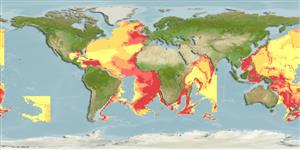>
Gadiformes (Cods) >
Macrouridae (Grenadiers or rattails)
Etymology: Cetonurus: Greek, ketos = a marine monster, whale + Greek, oura = tail (Ref. 45335).
More on author: Vaillant.
Environment: milieu / climate zone / depth range / distribution range
Ecología
marino batipelágico; rango de profundidad 860 - 4621 m (Ref. 11953), usually 1000 - 2000 m (Ref. 3587). Deep-water
Atlantic and Pacific: Eastern Atlantic: Bay of Biscay, Azores, off Mauritania, Senegal, and Canary Islands, Western Atlantic: Gulf of Mexico, east Caribbean. Western Pacific: Off Japan and Indonesia.
Tamaño / Peso / Age
Maturity: Lm ? range ? - ? cm
Max length : 50.0 cm TL macho / no sexado; (Ref. 3587)
Short description
Morfología | Morfometría
Radios blandos dorsales (total): 9-12. Band of small pointed teeth in both jaws. Body color brown to dark brown, gular and branchiostegal membrane darker. Membranes of mouth, gill cavities and body cavity blackish (Ref. 37108).
Feeds on small fishes and planktonic crustaceans (Ref. 6187).
Life cycle and mating behavior
Madurez | Reproducción | Puesta | Huevos | Fecundidad | Larva
Iwamoto, T. and A. Williams, 1999. Grenadiers (Pisces, Gadiformes) from the continental slope of western and northwestern Australia. Proc. Calif. Acad. Sci. 51(3):105-243. (Ref. 35909)
IUCN Red List Status (Ref. 130435)
Threat to humans
Harmless
Human uses
Más información
Nombres comunesSinónimosMetabolismoDespredadoresEcotoxicologíaReproducciónMadurezPuestaAgregación para la puestaFecundidadHuevosEgg development
Age/SizeCrecimientoLength-weightLength-lengthLength-frequenciesMorfometríaMorfologíaLarvaDinámica larvariaReclutamientoAbundanciaBRUVS
ReferenciasAcuiculturaPerfil de acuiculturaRazasGenéticaElectrophoresesheritabilidadEnfermedadesProcesamientoNutrientsMass conversion
Herramientas
Special reports
Download XML
Fuentes de Internet
Estimates based on models
Preferred temperature (Ref.
123201): 2.3 - 6, mean 3.7 °C (based on 2783 cells).
Phylogenetic diversity index (Ref.
82804): PD
50 = 0.7500 [Uniqueness, from 0.5 = low to 2.0 = high].
Bayesian length-weight: a=0.00102 (0.00046 - 0.00225), b=3.06 (2.88 - 3.24), in cm total length, based on all LWR estimates for this body shape (Ref.
93245).
Nivel trófico (Ref.
69278): 3.9 ±0.60 se; based on food items.
Resiliencia (Ref.
120179): Muy bajo, población duplicada en un tiempo mínimo superior a 14 años (Preliminary K or Fecundity.).
Fishing Vulnerability (Ref.
59153): Moderate vulnerability (40 of 100).
